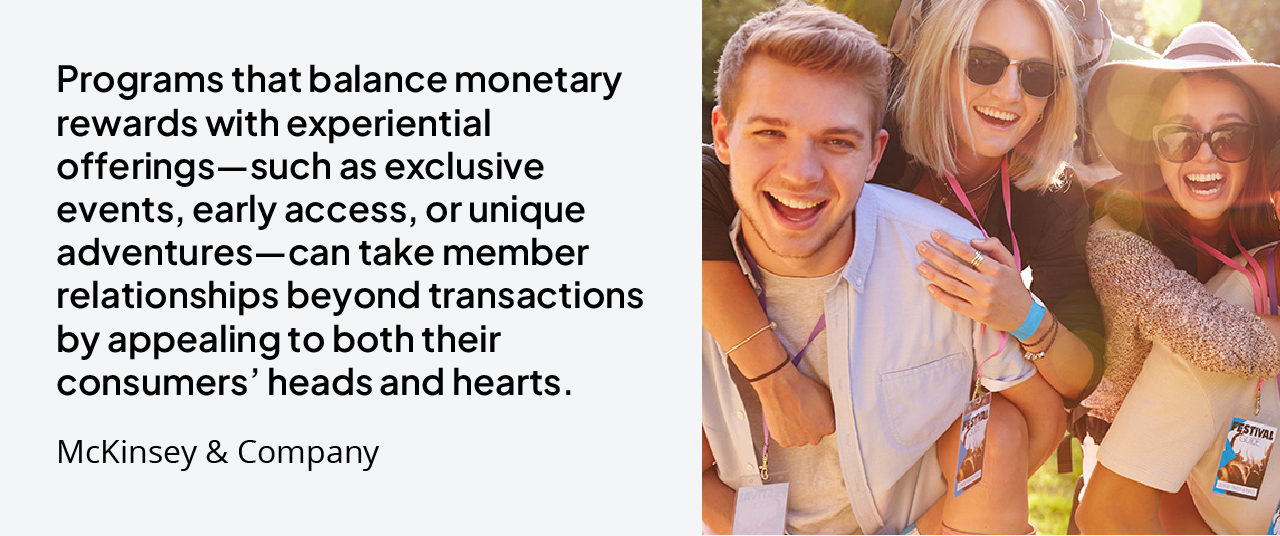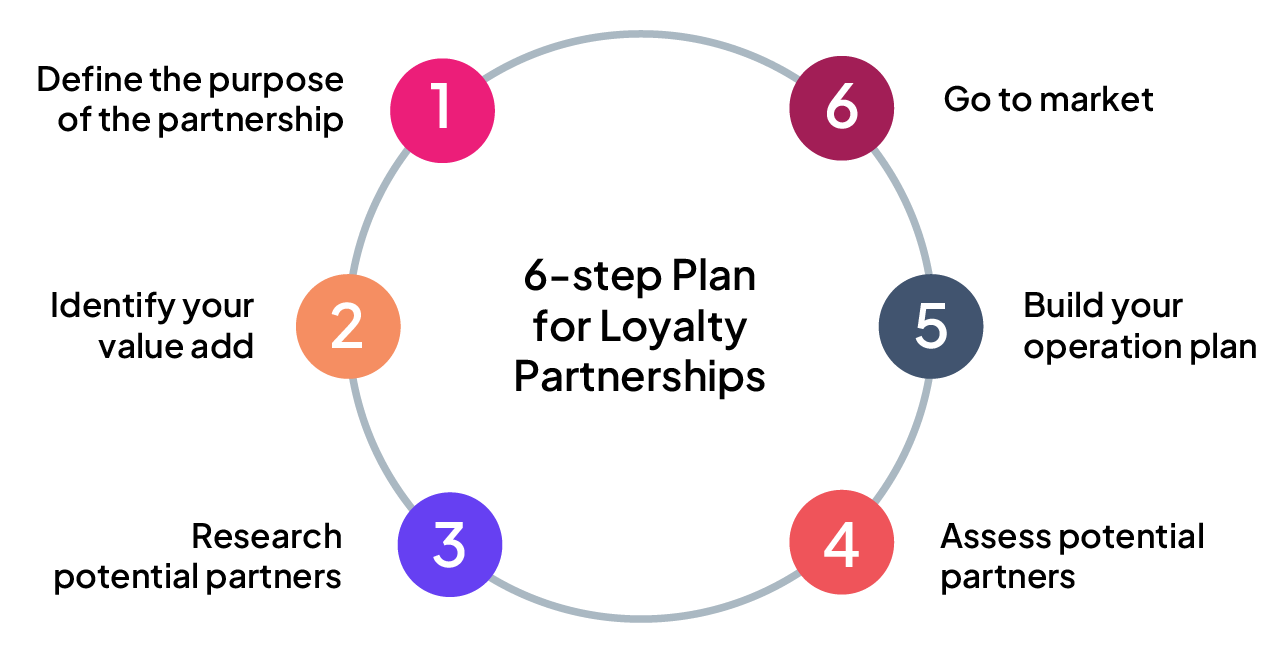Customer loyalty is essential for any company that wants to grow and thrive. But today’s loyalty programs must go beyond transactions to engage members between purchases, across all touchpoints. Gallup reports fully engaged customers represent a 23% premium in terms of share of wallet, profitability, revenue and relationship growth compared to the average customer.
By partnering with other companies, you can provide your customers with additional value and create a more compelling value proposition, giving them more reasons to engage with your brand more frequently. In this article, we’ll discuss three ways partnerships can help your brand take customer loyalty to a whole new level.
3 ways partnerships can elevate your loyalty program
We’re all familiar with big brand partnerships, such as United Airlines and Hilton Hotels—but partnerships between smaller, even local, partners can also work effectively. McKinsey & Company reports that partnerships help brands keep up with today’s dynamic, ever-changing consumers, and can even provide some brands with a new way to compete. In a recent episode of our
Get Personal with Loyalty podcast, David Slavick, Co-founder and Partner of Ascendant Loyalty, advises that partnerships work best if your loyalty program is mature, you have a decent size customer base and you have a clear understanding of your member personas.
“Partnerships work best if your loyalty program is mature, you have a decent size customer base and you have a clear understanding of your member personas.”
–David Slavick, Co-founder and Partner, Ascendant Loyalty
Here are three ways corporate partnerships can help you elevate your loyalty program:
1. Expand your value proposition
One of the most significant benefits of partnerships is they can expand the value proposition for both brands’ customers. When complementary brands partner together, both can offer their customers products, services or unique experiences they may not have been able to provide on their own. This can create a more compelling reason for customers to stay loyal to these brands. David Slavick advises brands to make sure their partnership delivers exclusive value, not a me-too offer member can easily get elsewhere. Partnerships give you an opportunity to get creative, so long as they align with your brand and business goals.
You might think a restaurant and grocery store partnership wouldn’t work. But consider grocery store customers who buy a lot of vegan products. They might jump on offers from a vegan restaurant.
Launched in June 2021, Bilt Rewards was the first rewards program that let you earn loyalty points on rent. In addition to helping renters, the program adds value to landlords by motivating renters to pay on time.
Uber and Spotify joined forces to offer riders the ability to play their favorite Spotify playlists during their rides. This partnership enhances the overall experience for riders and creates a more compelling reason for them to continue using Uber over other ride-sharing services.
According to McKinsey & Company, programs that balance monetary reward with experiential offerings—such as exclusive events, early access, or unique adventures—can take member relationships beyond transactions by appealing to both their consumers’ heads and hearts.

Jodi Rausch, Managing Director of Integrated Loyalty Solutions at Concentrix Catalyst, points out how brands are leveraging partnerships successfully. “We continue to see big brands create partnerships which, when done the right way, are very exciting and great for members. For example, the ability to connect your ULTA and Target Circle memberships to double dip in both programs is meaningful and very member friendly.”
2. Improve customer acquisition
Another way partnerships benefit brands is by providing cross-marketing opportunities and increasing customer engagement. This enables your brand to tap into new audiences and expand your reach beyond your existing customer base. Agreeing to promote each other to existing customer bases can lead to an immediate lift in sales for both brands.
This is especially helpful when high-frequency brands, such as gas stations or grocery stores, partner with lower-frequency brands, such as travel or entertainment. The high-frequency brands help members earn points to use for the lower-frequency brand’s products and services.
Partnerships of this nature can attract new customers through increased experiential benefits, faster loyalty rewards growth or more flexible redemption options. And acquisition costs for both brands go down.
3. Gain access to more robust customer data
The more data you have about your customers, the more insights you can glean to fine-tune your targeting and campaign efforts. This leads to better marketing performance. For example, by pooling your data with your partner’s data, you may know sooner when a customer is reaching a new level or reaching a new life milestone. And buying certain items could indicate a high-spend customer.
Consider the partnership between Nike and Spotify. Customers were encouraged to create a running playlist and were rewarded with a free, week-long trial of Spotify premium. This created immediate customer value because runners often like to track their fitness and listen to music. Doing this with one app is a lot more convenient for the customer.
If Spotify and Nike shared their data effectively around this campaign, they would have harnessed some incredibly useful data, such as:
-
Knowing how often people run and for how long (which might help you calculate when someone might be ready to buy a new pair of sneakers)
-
Knowing which music customers like to listen to when they run (enabling relevant song suggestions of a similar tempo and style)
-
Knowing what other fitness activities customers enjoy (enabling them to suggest other music and apparel options)
A 6-step plan for partnership loyalty programs

Adam Posner, CEO & Founder of The Point of Loyalty, advises brands to take these six key steps as they go down the partnership loyalty path:
1. Define the purpose of the partnership—This can include extending your brand’s value proposition, adding value to members’ lives, gaining new members, gaining more share of wallet from existing customers, increasing engagement to weekly or daily and more.
2. Identify your value add—What value does your loyalty program and member base offer to potential partners?
3. Research potential partners—Consider a range of categories, brands and products and services your members want that you can’t provide directly. Asking your frequent customers where else they shop can help identify possible contenders.
4. Assess potential partners—Score your potential partners and rank based of which are the best fit.
5. Build your operation plan—This should include implementation criteria, resources and budget required and technology considerations.
6. Go to market—Map out how you’ll promote and communicate your partnership, and how you’ll report results.
Powerful loyalty partnerships work
Partnerships can help you elevate your loyalty program to new levels and give you a unique competitive edge, while bringing added value to your customers. Partnerships are just one trend we unpack in our recent loyalty trends guide. Read all 11
loyalty trends
and gain valuable insights from leading loyalty experts. If you’re ready to modernize your loyalty program and start building lasting emotional bonds with your customers,
let’s chat.



